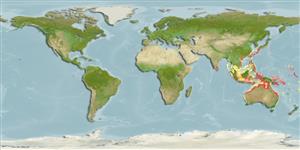>
Carangaria/misc (Various families in series Carangaria) >
Leptobramidae (Beachsalmon)
Etymology: Leptobrama: Greek, leptos = thin + old French breme, bresme, a fresh water fish; 1460 (Ref. 45335).
More on author: Steindachner.
Environment: milieu / climate zone / depth range / distribution range
بوم شناسي
دريايي; آب شيرين; لب شور سطح زی. Tropical
Indo-West Pacific: northern Australia.
Size / Weight / سن
Maturity: Lm ? range ? - ? cm
Max length : 37.5 cm SL جنس نر / بدون خواص جنسي; (Ref. 30691)
توصيف مختصر
ريخت شناسي | ريخت ستجي بوسيله انداره گيري
مهره ها: 24. This species is distinguished by the following set of characters: head length 21.7-22.7 % SL, snout length 19.9-24.5 % HL, upper jaw length 53.0-61.3 % HL, snout length 35.6-43.4% of upper jaw length; total gill rakers 13-18; scale rows below lateral line 13-14; vomerine tooth patch is rhomboid; tip of pectoral fin is almost same level as tip of appressed pelvic fin; lateral line gradually curved anteriorly. Colouration: a prominent black spot distally on anterior dorsal fin, with its size almost same as eye diameter or larger (Ref. 129587).
This species is apparently living inshore and migrating into brackish water as the specimens used in this study were collected from the lower reaches of rivers, estuaries or inner part of bays (Ref. 129587).
Life cycle and mating behavior
بلوغ | تولید مثل | تخم ریزی | تخم ها | Fecundity | توزاد ( لارو)
Kimura, S., T. Peristiwady and R. Fricke, 2016. Taxonomic review of the genus Leptobrama Steindachner 1878 (Perciformes: Leptobramidae), with the resurrection of Leptobrama pectoralis (Ramsay and Ogilby 1887). Ichthyol. Res. 63:435-444. (Ref. 129587)
وضعيت در فهرست قرمز IUCN (Ref. 130435)
خطر برای انسان ها
Harmless
استفاده انسانی
اطلاعات بيشتر
اسامي عاممترادفسوخت و سازشکارچیانسم شناسي بوم زيستيتولید مثلبلوغتخم ریزیSpawning aggregationFecundityتخم هانمو تخم
Age/Sizeرشدطول - وزنطول - طولنوسانات طولیريخت ستجي بوسيله انداره گيريريخت شناسيتوزاد ( لارو)پويايي لارويبازسازیفراوانيBRUVS
مراجعآبزي پرورينمايه آبزي پرورينژادهاژنتيكElectrophoresesوارثبيماري هافرآوریNutrientsMass conversion
همكارانعکس هاStamps, Coins Misc.صداهاسيگواتراسرعتنوع شناگریمنطقه آبششيOtolithsمغزهابینایی
ابزارها
گزارش های ويژه
بارگيری XML
منابع اينترنتي
Estimates based on models
Preferred temperature (Ref.
123201): 24.1 - 28.9, mean 27.7 °C (based on 544 cells).
Phylogenetic diversity index (Ref.
82804): PD
50 = 1.5000 [Uniqueness, from 0.5 = low to 2.0 = high].
Bayesian length-weight: a=0.01122 (0.00514 - 0.02450), b=3.04 (2.87 - 3.21), in cm total length, based on all LWR estimates for this body shape (Ref.
93245).
Trophic level (Ref.
69278): 4.5 ±0.8 se; based on diet studies.
Fishing Vulnerability (Ref.
59153): Moderate vulnerability (36 of 100).
